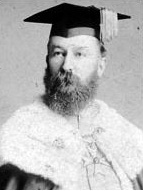Telfair Hodgson facts for kids
Quick facts for kids
Telfair Hodgson
|
|
|---|---|
 |
|
| Born | March 14, 1840 Columbia, Virginia, U.S.
|
| Died | September 11, 1893 (aged 53) Sewanee, Tennessee, U.S.
|
| Alma mater | Princeton University General Theological Seminary |
| Occupation | Episcopal priest, academic administrator |
| Spouse(s) | Frances Glen Potter |
| Children | 2 sons (including Telfair Hodgson Jr.), 1 daughter |
| Relatives | Benjamin F. Cheatham (daughter-in-law's father) |
| Military career | |
| Allegiance | |
| Service/ |
Confederate States Army |
| Years of service | 1861–1865 |
Telfair Hodgson (born March 14, 1840 – died September 11, 1893) was an American priest and a leader in education. He worked at Sewanee: The University of the South, where he was the head of the Theological Department from 1878 to 1893. He also served as the university's vice chancellor from 1879 to 1890. Hodgson helped start The Sewanee Review, a well-known literary magazine, and was its managing editor.
Contents
Early Life and Education
Telfair Hodgson was born on March 14, 1840, in Columbia, Virginia. He went to Princeton University and finished his studies there in 1859. While at Princeton, he joined a group called the Kappa Alpha Society. After Princeton, he continued his education at the General Theological Seminary in New York City.
Career Highlights
When the American Civil War began, Hodgson paused his seminary studies. He joined the Confederate States Army as a private soldier. He first served in the 44th Virginia Infantry and later moved to the 1st Regiment Alabama Infantry. This Alabama regiment was led by his brother, Colonel Joseph Hodgson. Telfair Hodgson was later promoted to work on the staff of General Joseph Wheeler.
In 1863, he became an Episcopal deacon, which is a step in becoming a priest. The next year, in 1864, he became a priest in Macon, Georgia. During the war, he worked as a chaplain in a hospital, helping soldiers. After the war, Hodgson traveled to Europe and lived there for a while in 1869–1870.
Teaching and Church Work
From 1872 to 1873, Hodgson was a professor of Philosophy at the University of Alabama. In 1874, he worked as an assistant leader at Christ's Church in Baltimore, Maryland. He then became the main leader (rector) of Trinity Church in Hoboken, New Jersey, serving there from 1874 to 1878. Some of his speeches during this time honored soldiers who died in the Civil War.
In 1876, Hodgson gave $10,000 to Sewanee: The University of the South. This money helped build the university's first stone library.
Leadership at Sewanee
Theological education, which is the study of religion, became very important at Sewanee after the university started accepting students in 1868. The Sewanee Training and Divinity School later joined with the university.
In 1878, Telfair Hodgson was hired as the head (dean) of the Theological Department at Sewanee. He held this important position until 1893. He also served as the university's vice chancellor from 1879 to 1890. As a leader, he supported the building of other important university structures, like Thompson Union and Convocation Hall.
The Sewanee Review
In 1892, a professor named William Peterfield Trent started a literary magazine called The Sewanee Review. Hodgson became a key supporter of this magazine. He provided the money needed to run it and worked as its managing editor. This allowed Trent to focus on the stories and articles that went into the magazine.
Family and Later Life
Telfair Hodgson married Frances Glen Potter. They had two sons, Telfair Hodgson Jr. and J. H. P. Hodgson, and one daughter.
Telfair Hodgson passed away on September 11, 1893, in Sewanee, Tennessee. His son, Telfair Hodgson Jr., later became the treasurer of the University of the South, serving from 1908 to 1949.
The Sewanee Review, which Hodgson helped establish, is still published today. It is the oldest literary magazine in the United States that has been published without stopping.

